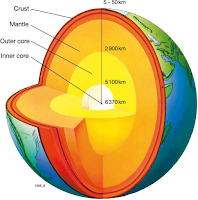The geosphere consists of the solid proportion of the Earth and extends from the inner core to the crust, yet is predominantly classified as the lithosphere; the upper mantle and crust. The lithosphere is the area that affects Earth systems the most, as it is the rock forming portion of the Earth and therefore dictates the landmasses upon which we live.
Figure 10 cross section of Earth (Retrieved from: http://media.diercke.net/omeda/800/10155E_8_Erde_Schalenbau.jpg Date 20/9/2015)
The lithosphere formed shortly after the Earth formation as it underwent cooling, solidifying the molten rock to form the crust. From this the oldest rocks on the planet, the Acasta Gneiss, in Canada have given an age of 4.06 billion years. Yet the age of the Earth is given to be 4.56 billion years old, an age which has been determined by radiometric dating of meteorites. From this we know that the meteorites formed 4.56 billion years ago it can be inferred that the Earth formed in the same system due to similar compositions (meteorites made of rocks found on Earth) and so shares the same age. Zircon minerals found within the sedimentary rocks of Jacks Hill, have given an age of 4.4 billion years.
So why are there three different ages?
These conditions are a result of igneous, sedimentary and metamorphic processes all of which happen due to plate tectonics (PT). Plate tectonics is the movement of large crustal bodies that are defined by plate boundaries. An age for the formation of plate tectonics has yet to be determined as early stages of the Earth had rocks form there is no evidence of PT, a reason for this is that the mantle was too hot for plates to form and made the crust to buoyant for any movement (Retrieved from: https://geosociety.wordpress.com/2013/04/28/when-did-plate-tectonics-begin-on-earth-and-what-came-before/ Date 11/9/2015).
Eventually tectonic plates formed and started to move. This movement is driven by two factors:
These two movement processes allow the plates to move apart and collide, creating three different boundaries; convergent, divergent and transform.

Plate Boudaries and with associated properties (Retrieved from: http://media-2.web.britannica.com/eb-media/53/4953-004-C647C3B2.jpg Date 15/9/2015).
Its at theses boundaries where most of the planets rocks are formed.
 |
| Plate Boudaries and with associated properties (Retrieved from: http://media-2.web.britannica.com/eb-media/53/4953-004-C647C3B2.jpg Date 15/9/2015). |


No comments:
Post a Comment